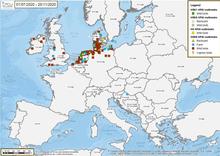In Russia and Kazakhstan, a high number of highly pathogenic avian influenza (HPAI) outbreaks were detected between August and September in combination with the presence of a high number of migratory birds susceptible to migrate towards Europe and Belgium during the autumn. Therefore, increased vigilance was requested from European member states since the end of September. In this context, increased passive surveillance of wild birds is initiated in Belgium in collaboration with the three Regions (Nature and Forest Agency, Department of Nature and Forests, and Brussels Environment).
Three subtypes HPAI are currently circulating in Europe:
- H5N8 (the majority)
- H5N1
- H5N5
These subtypes resulted from new combinations of reassortment of HPAI with low pathogenic avian influenza viruses.
After the HPAI virus was detected in wild birds in Belgium, several control measures have been imposed by the Federal Food Agency to the commercial poultry sector since November 1st. These control measures were extended to all poultry since mid-November1.
The first detection in wild birds in Belgium occurred on the 13th of November in 3 birds:
- a swan staying in the bird shelter of Ostend (VOC)
- a curlew from Wilskerke
- a white-fronted goose from Bredene.
The swan resident at the Ostend Bird Care Centre showed neurological symptoms as did the curlew and the white-fronted goose brought to the Centre. All three birds were euthanized and diagnosed as H5-HPAI. Based on sequence information, it was confirmed that these were 2 different H5N8 viruses: on the one hand for the swan and for curlew and white-fronted goose on the other hand. Until the 20th of November, the HP H5N8 virus was detected in 4 swans, 2 curlews, 1 white-fronted goose, 1 herring gull, 1 magpie and 1 Turkish dove. The first full-length sequence, from the first swan, has already been submitted to Gisaid*.
The figure below, established by the European reference laboratory IZsVe in Italy, gives an overview of the cases of the virus detected in Europe2. An overview of the infections in Belgium in wild birds and poultry is available on the website of the FASFC3.

On November 26th, an outbreak of a highly pathogenic avian influenza H5 has been confirmed in a broiler exploitation in the province of West Flanders4. It was the first time since 2017 that a HPAI outbreak occurred in a poultry holding in Belgium. To limit further propagation of the virus, the Federal Food Agency implemented supplementary measures.
The National Reference Laboratory (NRL) or Avian Influenza and Newcastle disease of Sciensano plays an important role in in performing all the laboratory analyses and in providing scientific advice regarding the outbreak to the Authorities. The evolution of the situation is closely monitored, in concertation with the regions and the Federal Food Agency (FASFC).
1 http://www.afsca.be/professionelen/dierlijkeproductie/dierengezondheid/v…
2 https://www.izsvenezie.com/reference-laboratories/avian-influenza-newcas…
3 http://www.afsca.be/professionelen/dierlijkeproductie/dierengezondheid/v…
4 http://www.favv.be/professionelen/publicaties/pers/2020/2020-11-26.asp
*accession numbers EPI-ISL-644735: EPI181327-EPI181334


